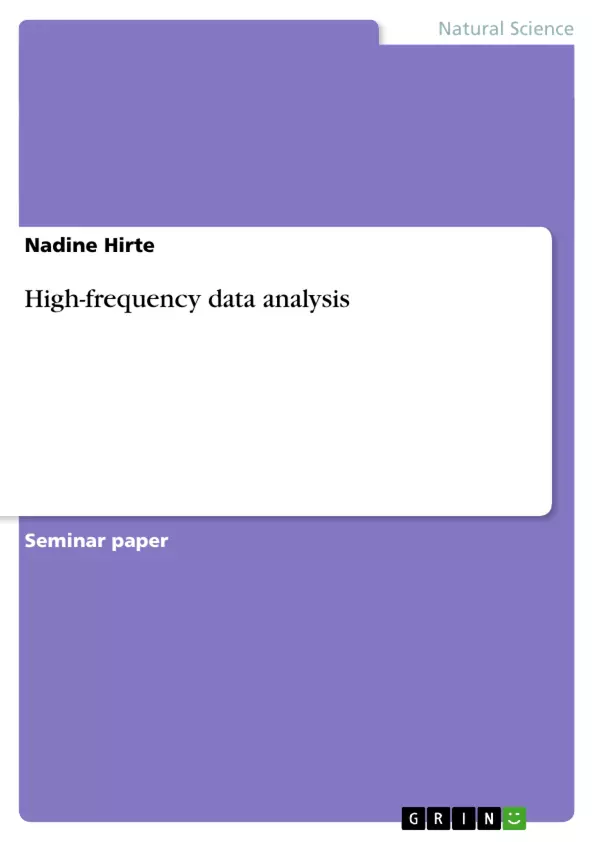Today the financial market becomes more complex and includes more competition.
Reasons are trends like globalization, liberalization and lower-cost trading
mechanism. The market microstructure research has the aim of an efficient market. It
is focused on the structure of the financial market. The investigation becomes
possible through the availability of high- frequency data. Those data exist especially
in the United States and like that most of the research focuses this market. To explain
the phenomena, which have been found adequate, models that fit the characteristics
of high- frequency data have to be developed.
The research is important to understand actions on the market as well as develop new
efficient mechanism. One part of the market microstructure field is the bid-ask
spread. It will be focus of this paper. In the first two parts it will be discussed
theoretically. In the last part one model will be empirically analyzed and tested on its
usefulness and validity.
The second part of this paper explains the basic elements surrounding the research of
bid-ask spread. Those are the financial market, market microstructure as well as
high-frequency data. In the following part the bid-ask spread itself, approaches,
researches and models focussing the spread will be discussed. The model of Roll
(1984) will be explained in detail. The last part will be the empirical analysis of the
model of Roll. It is analyzed with data from the NASDAQ.
Inhaltsverzeichnis (Table of Contents)
- Introduction
- Basic Facts
- Financial Market
- Market Microstructure
- High-Frequency Data
- Bid-Ask Spread
- Definition
- Approaches and Research
- Roll-Model (1984)
- Empirical Analysis of the Roll-Model
- Data Analysis
- Empirical Part
- Conclusions
- Final Remarks
Zielsetzung und Themenschwerpunkte (Objectives and Key Themes)
This paper examines the bid-ask spread, a key aspect of market microstructure research. Its main objective is to explore the theoretical underpinnings of the bid-ask spread and analyze its practical application through the lens of the Roll model (1984). The analysis utilizes high-frequency data from the NASDAQ to test the model's effectiveness and validity.
- The importance of understanding market microstructure in achieving efficient markets
- The role of high-frequency data in analyzing financial market phenomena
- The theoretical and practical aspects of the bid-ask spread
- The empirical analysis of the Roll model for bid-ask spread using NASDAQ data
- The significance of efficient trading mechanisms in today's complex and competitive financial market
Zusammenfassung der Kapitel (Chapter Summaries)
- Introduction: This chapter provides a broad overview of the research's focus on market microstructure, specifically the bid-ask spread. It highlights the significance of high-frequency data and the importance of developing models that capture the characteristics of such data.
- Basic Facts: This chapter lays the foundation for understanding the concepts surrounding the bid-ask spread. It discusses the financial market, market microstructure, and high-frequency data. This section provides context and definitions essential for understanding the later analysis.
- Bid-Ask Spread: This chapter delves into the definition and various approaches and research surrounding the bid-ask spread. It explores the theoretical background and introduces the Roll model (1984), which will be the subject of the empirical analysis in subsequent chapters.
- Empirical Analysis of the Roll-Model: This chapter focuses on the practical application of the Roll model. It outlines the data analysis process, the empirical methodology, and the findings derived from testing the model on NASDAQ data. This section is crucial for understanding the model's effectiveness and validity.
Schlüsselwörter (Keywords)
This paper focuses on key concepts such as market microstructure, high-frequency data, bid-ask spread, Roll model (1984), empirical analysis, NASDAQ data, and efficient markets. These concepts are central to understanding the dynamics of the financial market and the role of the bid-ask spread in achieving efficient trading mechanisms.
- Quote paper
- Nadine Hirte (Author), 2003, High-frequency data analysis, Munich, GRIN Verlag, https://www.grin.com/document/26082



